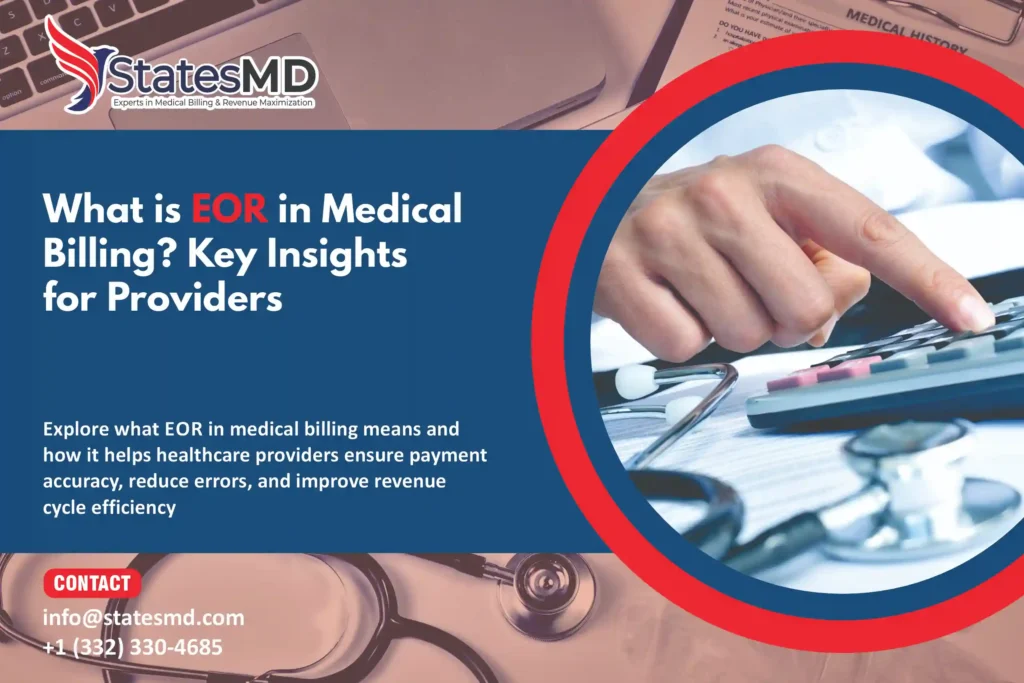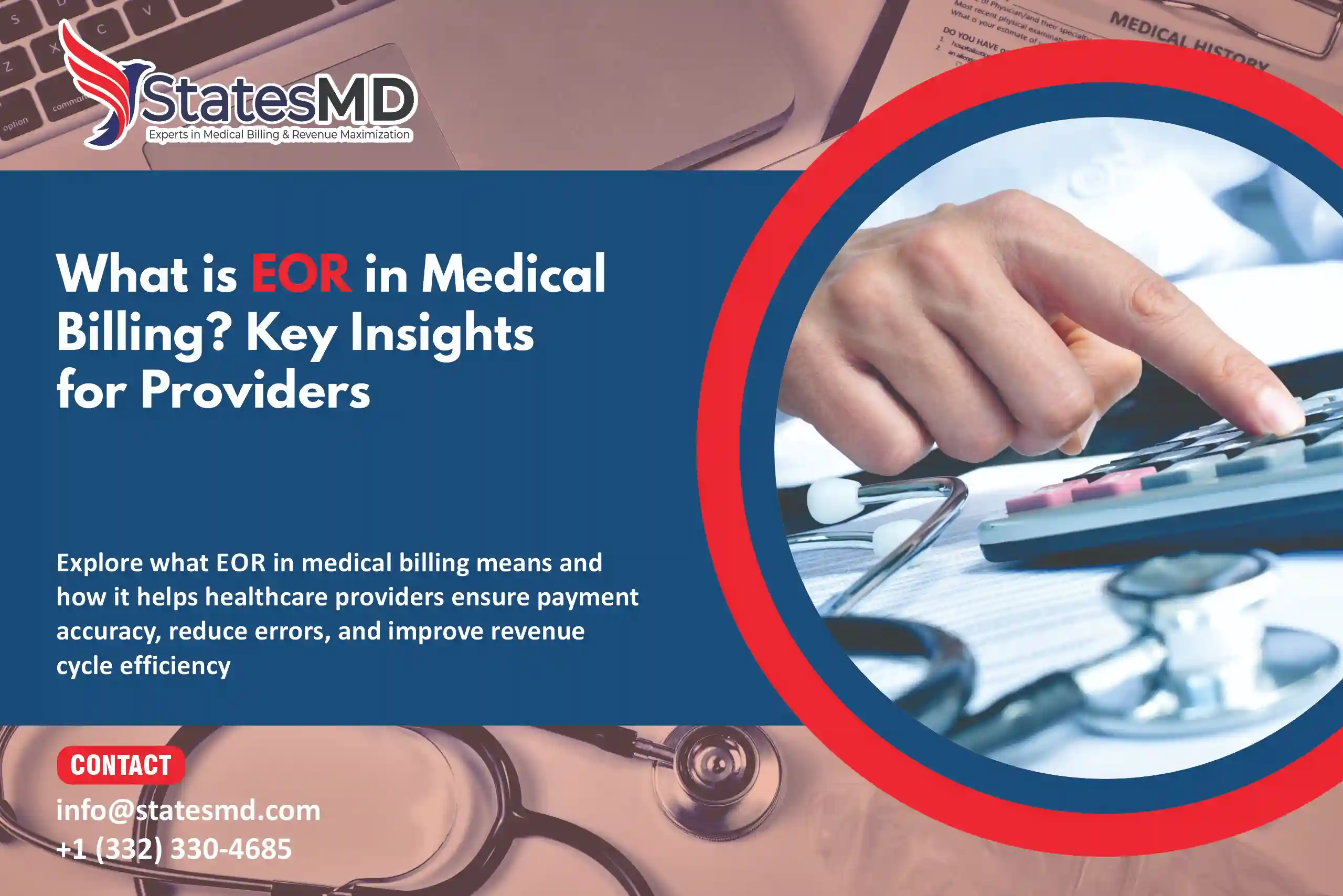Have you ever wondered why some of your medical claims are denied or delayed while being correctly submitted? The Explanation of Benefits (EOR) could be key to understanding why. EORs are important papers demonstrating how insurance companies process claims, including what was paid, denied, or changed. According to the Healthcare Financial Management Association (HFMA), 60% of healthcare providers experience payment delays owing to improper claim submissions, many of which can be avoided with a better understanding of EORs.
Understanding these documents helps medical billers and healthcare providers avoid costly errors and ensure appropriate payments. In 2021, the U.S. healthcare system lost over 125 billion dollars due to billing errors, many of which were caused by faulty claim handling or unknowns about EOR facts.
Understanding how to read and comprehend these documents can help healthcare professionals save time and money while increasing the revenue cycle’s overall efficiency.
Learn more about EOR in medical billing.
The Explanation of Review (EOR) is a key document in the medical billing process. It provides detailed information on how an insurance claim was processed, including payment breakdowns, adjustments, or denials.
What Does “EOR” Stand For?
An EOR, or Explanation of Review, is a detailed report issued by insurance companies. It outlines:
- Claim decisions: What parts of a claim were allowed or denied?
- Payment breakdown: Reimbursed amount, adjustments, and patient responsibility.
- Reasons for Denial or Adjustment: Detailed codes and explanations for any discrepancies.
Importance of EOR in medical billing
EOR records are crucial to effective revenue cycle management. Their importance includes:
- Error Identification: Identify claim errors that require correction or appeal.
- Payment Accuracy: Confirm that payments are consistent with contractual agreements.
- Compliance: Ensure that all billing practices follow regulatory standards.
How EOR Affects Medical Billing
Explanation of Review (the EOR) is an important part of medical billing since it impacts claims processing, revenue management, and compliance. Understanding how EOR affects these areas can assist healthcare personnel in improving billing processes and reducing errors.
EOR & Claims Processing
The EOR provides complete remarks on insurance claims. It highlights:
- Claim approval or denial: Describes why claims were approved or denied.
- Payment Details: This includes payment changes and the patient’s financial responsibilities.
- Error Identification: Finds issues such as missing codes or improper charges.
EOR & Revenue Cycle Management
Revenue cycle management has a major impact on correct EOR interpretation. It helps in:
- Optimizing cash flow: Payments must be following the contract.
- Reducing claim errors. Identifying problems to be resolved.
- Enhancing efficiency: streamlining appeals for denied claims.
Key Information Found in EOR
Every EOR contains essential information such as
- Patient and provider information: Ensures that claims get submitted to the proper parties.
- Service Descriptions: Procedures, codes, and bill amounts are all listed.
- Denial codes and explanations: Provides reasons for claim modifications or denials.
The Role of EOR in Resolving Billing Disputes
EOR in medical billing is critical for addressing billing issues. , resulting in correct payments and fewer lengthy disputes.
Using EOR to Identify Payment Discrepancies
EOR provides payment amounts, adjustments, and denials. Key areas to check include:
- Discrepancies between bills and payments: EOR highlights underpayments and overpayments.
- Payment adjustments: Explain the reason for changes in payment amounts.
- Correct claim information: Ensures all costs are appropriate for the services provided.
EOR and Patient Responsibility
EOR clarifies the patient’s payment responsibilities. This includes:
- Deductibles: These are the amounts that patients must pay before their insurance coverage begins.
- Co-pays and co-insurance: The amount of the bill that the patient is responsible for after insurance.
- Out-of-pocket maximums: The highest amount a patient must pay for services throughout a plan year.
How to Use EOR for Denial Management?
EOR can guide the denial management process by:
- Identifying rejection reasons: EOR provides codes and reasons for claim rejection.
- Appealing denied claims: Understanding why a claim was refused can aid in developing effective appeal tactics.
- Error correction: A review of the EOR can assist in resolving coding faults or missing information.
Common Challenges With EOR in Medical Billing
Understanding the issues of EOR can assist healthcare providers and billers solved frequent difficulties. Issues such as lack of transparency, managing complex claims, and delayed EOR responses can all disrupt billing procedures and cause payment delays.
Lack of Transparency in EOR
Some EORs give unclear information, making it difficult to comprehend why changes or denials were issued. Common challenges include:
- Insufficient explanations for payment decisions.
- Incorrect coding or unclear denial reasons.
- There are few details available about patient responsibility.
EOR and Complex Claims
When claims include multiple services, procedures, or providers, EOR evaluations might become more complicated. Issues include:
- Inconsistent payments for bundled services.
- Disputes regarding medical needs.
- Complicated coordination between primary and secondary insurance payers.
Delayed EOR
The timely receiving of EORs is crucial for cash flow, yet delays are typical. Causes of delays include:
- Payroll processing backlogs.
- Errors in claim submissions result in rework.
- Postal delays for paper EORs.
How EOR Affects Insurance and Medical Billing Compliance
EORs (Explanation of Reviews) are crucial for preserving accuracy and compliance in medical billing and insurance claims. They are important for ensuring regulatory compliance, preventing fraud, and improving health information technology.
EOR and Regulatory Compliance
EORs ensure that billing methods conform with legal and industry demands by providing:
- Details about payer adjustments and denials.
- Explanations for complying with insurance regulations.
- Proof of compliance with state and federal guidelines.
How EOR Can Prevent Billing Fraud
EORs provide transparency, making them an effective tool for detecting and preventing fraudulent billing. They help by
- Highlighting errors in coding or charges.
- Identifying overpayments or duplications.
- Documenting payer determinations for audits.
The Impact of EOR on Health Information Technology (HIT)
EOR integration with HIT systems improves billing processes and data accuracy. Key advantages include:
- Faster detection of claim discrepancies.
- Better communication between payers and providers.
- EORs are digitized for ease of storage and retrieval.
Conclusion
The Explanation of Review (EOR) is an important tool in medical billing since it clarifies claims processing, payment information, and compliance requirements. A thorough understanding of EORs enables healthcare providers to reduce errors, resolve disputes effectively, and enhance revenue cycle management. Medical billers can improve cash flow by appropriately assessing EORs and identifying mistakes. EORs are also essential for adhering to regulations and avoiding fraud. Utilizing this expertise enables healthcare workers to improve efficiency and compliance in medical billing procedures.
FAQs
1. What is an EOR in medical billing?
An EOR (Explanation of Review) is a document from insurance companies detailing how a claim was processed, including payments, adjustments, or denials.
2. Why is EOR important in medical billing?
EOR helps medical billers identify errors, understand payment decisions, and ensure claims comply with regulatory standards.
3. How does EOR help with denied claims?
EOR provides detailed codes and reasons for denials, enabling billers to correct errors and develop effective appeal strategies.
4. What information is included in an EOR?
An EOR contains patient and provider details, service descriptions, payment breakdowns, and denial explanations.
5. How does EOR affect revenue cycle management?
EOR ensures accurate payments, resolves claim discrepancies, and improves cash flow in the revenue cycle.




